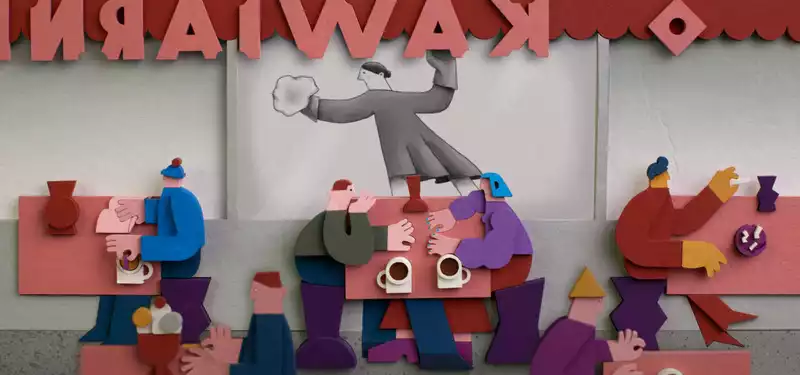Apr 11, 2022
Kijek/Adamski Drop Trailer for Stop-Motion/2D Short "Slow Light" - Exclusive
Polish animation duo Kijek/Adamski have released an exclusive trailer and behind-the-scenes look at their next film, "Slow Light," which will premiere at a film festival this summer.
Warsaw-based Katarzyna Kijek and Przemys.aw Adamski's Slow Light tells the tragic story of a boy born with eyes so dense that light takes seven years to reach his retina. Then, at the age of seven, he is finally able to see the events that took place around him when he was still a baby. From that moment on, his physical and psychological development is delayed, creating an immature character who struggles to adapt to the world around him. Literally, he is living in the past; watch the trailer, released exclusively on Cartoon Brew:
In the film, the two timelines are represented by different animation techniques. Everything the protagonist experiences is depicted in stop-motion with colorful cut-outs. However, the past as seen by his eyes is hand-drawn in black and white. The cutouts used in the production, estimated at 90,000, were painted over a period of seven months by a team of artists, and the hand-drawn portions were taken over by another group of animators in Portugal.
"Slow Light" is produced by Animoon ("Moomin and the Winter Wonderland," "Even Mice Are in Heaven," "Acid Rain") and co-produced by Cola Animation of Portugal. Miyu Distribution of France will distribute the film worldwide and is currently booking screenings at film festivals.
Kijek and Adamski spoke with Cartoon Brew for the film's trailer release and shared a behind-the-scenes look at the film's production in the video below.
Cartoon Brew: Why did you choose to use hand-drawn black and white animation for what happened in the past and colorful cut-outs for what is happening today? We often begin a new project by choosing a technique that we feel is important to convey a message. Clearly, narration can be an effective allegory and illustrate a larger concept, but it is techniques like posters that directly synthesize ideas and provide immediate access to the core of meaning. There is as much potential for expressive means as there is for storytelling.
In the case of this film, a clear distinction had to be made between two time frames. Since the past is experienced by the protagonist as a constant stream of images projected on the retina, we chose a traditional 2D technique with projection-like properties. When we thought about the current timeline, we wanted to emphasize its tactile qualities. We drew inspiration from the models displayed in museums and galleries to help the visually impaired understand works of art. At first glance, they are shaped in such a way that one can grasp reality, but at the same time they are not something that one can actually touch. The model is merely a medium for reality.
It is a unique idea to use a dual time frame and show how the protagonist suffers and lives within it.17]
At one point, I realized that we are caught up in a misrepresentation of past events and that the older we get, the more we reflect on the past. This seemingly obvious reflection led us to the darker realization that we are drawn to the past on a subconscious level and that if we want to remain relevant, we must make a constant effort to update our reference point in time.
The past is something we already understand, and it gives us a sense of security. This regularity works on many levels, but it has the heaviest consequences when it traverses two different eras and makes us yearn for a bygone era, even if it is objectively horrible. We have observed this sentiment many times in Poland, but it has become omnipresent worldwide and we are very concerned.
Tell us a little about the production process. How many people were involved and how was the division of labor? First we created a 1:1 prototype in After Effects, which we converted to illustrator paths and sent a series of files to the laser cutting workshop. Once we received the cut elements (184 sheets of 100 x 70 cm), we painted each one by hand and assembled the frame. The total number of parts used is virtually uncountable. Roughly estimated at 90,000 sheets, the eight-person team painted for approximately seven months.
And how was the 2D animation handled -
Once filming was complete, we were approached by the Portuguese production company Cora Animation, who joined the team and became co-producers. Thanks to this joint venture, we were able to optimize the workflow of the 2D animation production, with very satisfactory results. Thanks to talented animators such as Ara Nunu, Joan Gonzalez, Jakub Kaczmarek, Bartosz Stopnik, Hugo Sequeira, etc.
.



Post your comment